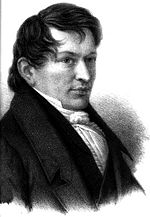Maurits Christopher Hansen
Maurits Christopher Hansen (born July 5, 1794 in Modum , † March 16, 1852 in Kongsberg ) was a Norwegian school teacher , principal , textbook writer , writer of the Late Enlightenment and Romanticism .
Life and career
His parents were the chaplain and later pastor Carl Hansen (1757-1826) and his wife Abigael Wulfsberg (1758-1823). On October 20, 1816 he married the teacher Helvig Leschly (April 23, 1789-26 February 1874), daughter of the customs collector and reserve major Mauritz Leschly (1758-1820) and his wife Elen Marie Bergwitz (1760-1823).
Hansen grew up in Porsgrunn and Skedsmo . In 1809 he attended the Kristiania katedralskole high school , where he finished his education in 1814.
He then enrolled at the Kristiania University for Philology and Aesthetics. His economically tight circumstances forced him to earn his own living, so that he neglected his studies. In 1815 he became a teacher at the civil school in Christiania, in 1816 a teacher at the war school. In 1817 he and his wife founded a girls' secondary school, which they both ran until 1820. Then he came to the Realschule in Trondheim. In 1825 he became an assistant teacher at the cathedral school in Trondheim and from 1826 rector at Kongsberg middelskole until his death in 1842. Here, too, he ran a girls' school with his wife. The establishment of two girls' schools is strong evidence that Hansen - contrary to the widespread opinion of his time - gave women a natural right to education. His daughter Johanne Kathrine, for example, was tutored by himself with the aim of preparing her for the university entrance examination.
Act
As a textbook author, he wrote a large Norwegian grammar, but in the fifth edition in a radically simplified orthography, as it was only accepted around 1900. It was therefore not used at the time. But the fourth edition was reprinted until 1858. For a while he was also the editor of Morgenbladet's “Aesthetic Sunday Number ”, later of the magazine Den norske Huusven (The Norwegian House Friend) and the picture magazine for children.
He established his reputation as a poet through Digtninger (1816). This was followed by novellist works that are characterized by fantasy and realistic perception of popular life, such as:
- Lurs ,
- Bergmanden ,
- Den gale Christian and others, also the dramas:
- Nor og Gor , in celebration of the unification of the two Scandinavian empires, and
- Hakon Athelstan (1838) and the novel
- Polycarps supplerede manuscripts eller en Slægts Historie .
Also as a lyricist and idyllic poet, e.g. B. in the Norsk Idylkrands (Christiana, 1831), Hansen occupies an honorable place. A collection of his writings appeared in Bergen from 1841–1843. Schwach published his Noveller og Fortællinger (Christiana 1855-1858, 8 volumes).
Hansen is considered to be one of the first writers of Norwegian novels. He wrote in different genres, among other things he created the first Norwegian farmer's stories and published the crime story Mordet på Maskinbygger Roolfsen. Criminal anecdote from Kongsberg (1839, "The murder of machine manufacturer Roolfsen. Criminal anecdote from Kongsberg"), two years before Edgar Allan Poe's The Murders in the Rue Morgue (1841) appeared.
Maurits Hansen was best known for his novels , many of which are crime stories. He wrote 80 short stories in 20 years. He was influenced by Friedrich de la Motte Fouqué , sir Walter Scott . Henrik Ibsen learned his retrospective unveiling technique from Hansen's works.
Works
Fiction
- Digtninger, samlede 1816. 1816.
- Othar af Bretagne. 1819. (New edition 1994: ISBN 82-7488-042-0 )
- Digtninger, samlede 1825. 1825.
- Eventyret ved Rigsgrændsen. 1828.
- Norsk Idylkrands. 1831.
- The forskudte. 1838.
- Murder paa Maskinbygger Roolfsen. 1840 [= December 1839]. (New edition 2004: ISBN 82-05-23928-2 )
- Clays. 1843.
- Mauritz Hansen's Noveller and Fortællinger. 8 volumes. 1855-1858.
- Brødrene. 1866.
- Novellas. 1827.
Textbooks
- Forsøg til en grammar in Modersmaalet. 1822.
- Practisk Veiledning i Modersmaalet. 1825.
- Kortfatt latinsk lexicon. 1831.
- Omrids af Geographien til Brug for Begyndere, især i Borger- og Almueskoler. 1831.
- ABC instructif four apprendre aux enfans les elemens de la langue francaise. 1833.
- Systematisk Fremdstilling af det latinske sprogs combinationslære. 1834.
- Skolegrammatics i det franske Sprog. 1834.
- Almindelig Verdenshistorie fra de ældste indtil vore Tider. 1838.
- Julie's Brevsamling. Practical advice to the breviary for young people. 1840.
literature
- Edvard Beyer and others: Norges literature history . Volume 2. Oslo 1991.
- Willy Dahl: Norges literature I: Tid og tekst 1814–1884. Oslo 1981.
- Willy Dahl: Forord. In: Maurits Hansen: Murder paa Maskinbygger Roolfsen. Oslo 1978.
- Morten Moi: Maurits Hansen. In: Norsk biografisk leksikon. Retrieved February 8, 2010.
- Harald S. Næss. (Ed.): Norwegian literature 1800-1860. 1993, pp. 82-106.
- CN weak: Maurits Hansens Noveller og Fortællinger. Volumes 1-8, Christiania 1855-1858
Individual evidence
- ↑ The citizen school was a fruit of the Enlightenment and represented an alternative to the Latin school. It was based on practically usable subjects spelling, mathematics, accounting, living languages and natural history. They were different depending on the size of the city. In Bergen, Trondheim and Christiania they were secondary schools, otherwise they were more comparable to middle schools.
- ↑ Edvard Beyer (Ed.): Norges literaturhistorie. Volume 2, pp. 69-70. (norw.)
- ^ Store norske leksikon: Maurits Hansen (norw.)
Web links
- Norsk biografisk leksikon : Maurits Hansen (norw.)
- Books by and about Maurits Hansen at the Norwegian National Library (mainly norw.)
- Maurits Hansen biography on scandinavische-krimis.com
| personal data | |
|---|---|
| SURNAME | Hansen, Maurits Christopher |
| BRIEF DESCRIPTION | Norwegian poet |
| DATE OF BIRTH | July 5, 1794 |
| PLACE OF BIRTH | Modum |
| DATE OF DEATH | March 16, 1852 |
| Place of death | Kongsberg |
